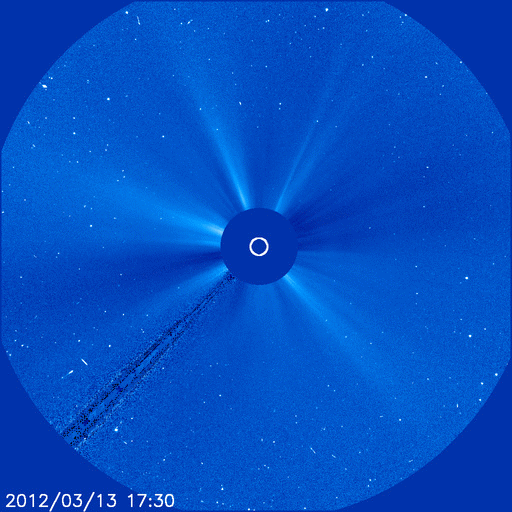Strictly speaking, there aren’t strict boundaries between Earth and space. Our atmosphere doesn’t just end at a certain altitude; it peters out gradually. A new study from Russia’s Space Research Institute (SRI) shows that our atmosphere extends out to 630,000 km into space.
Continue reading “Did You Know the Earth’s Atmosphere Extends Beyond the Orbit of the Moon?”So Long, SWAN…
Remember that newly-discovered comet we mentioned a couple of days ago? Well, it’s gone. Poof. Into the Sun and never to return, it was a sungrazer’s final voyage.
The video above features images from the SOHO spacecraft and description from Bad Astronomer Phil Plait, with music by Kevin MacLeod.
Alas, poor SWAN… at least we knew him.
Read more about the history of Comet SWAN on the Sungrazing Comets site. Video credit: NASA/SOHO (and thanks to Phil Plait for the assembly.)
A New Comet’s SWAN Dive Into the Sun
[/caption]
A new comet has been discovered by the SOHO team, and it — like Lovejoy before it, almost three months to the day — is headed directly toward the Sun. Discovered by SOHO’s SWAN instrument, the comet has been dubbed Comet SWAN… making this a real swan dive (or, perhaps more appropriately, its swan song.)
The animation above has a lot of random noise in it from recent solar outbursts… can you spot the comet? If not, read on…

There’s Comet SWAN, just above the darker silhouette of the bar that holds the shielding disk over the center of the imager (which blocks the glare from the Sun itself.)
The comet is likely another member of the Kreutz family of comets, an extended family of pieces that broke off a larger comet several hundred years ago (which itself may have been a survivor of a breakup in 371 B.C.!) Comet Lovejoy was also a Kretuz sungrazer but it was considerably larger and brighter, which may have helped it survive its Dec. 15 solar close encounter to re-emerge on the opposite side, surprising astronomers everywhere!
Read how some scientists think Comet Lovejoy held itself together.
SWAN may not be so lucky… but then again, we’ve been surprised before!
The comet will make perihelion — its closest approach to the Sun — on March 14. Stay tuned for more details!
Images via SpaceWeather.com.


